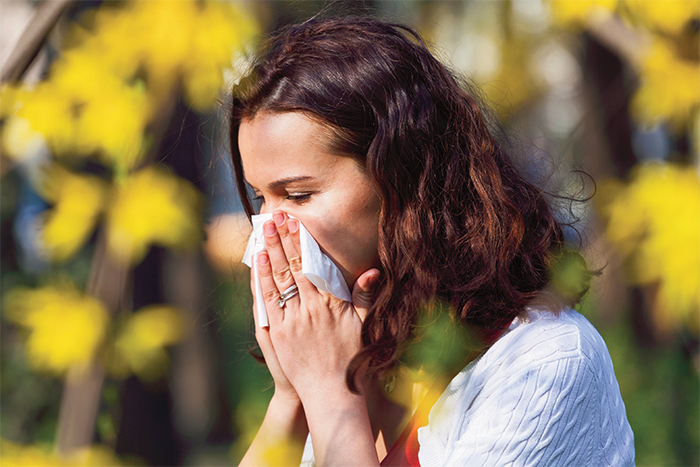OTC

A chain reaction
In OTC
Bookmark
Record learning outcomes
From pollen and dust mites to food and pets, allergies are varied and can affect anyone. With their prevalence only set to rise, there is a great opportunity for pharmacy teams to help sufferers by offering treatments, self care tips and prevention advice
According to Allergy UK, around 21 million people in the UK live with allergies, and cases are on the rise. A Mintel report in June 2017 revealed that overall, the market for allergy products in the UK increased by 5.6 per cent between 2015 to 2016 to reach £133.7 million. And while hayfever is very common, other allergies are causing troublesome symptoms, too.

In fact, the Mintel research showed that 48 per cent of customers aged 16-24 and 47 per cent of those aged 25-34 had experienced a seasonal allergy, such as hayfever, in the previous year, compared to just 25 per cent of Brits aged 55 and over. In the previous 12 months, 17 per cent of Brits had also suffered an allergy to house dust mites, 14 per cent reacted to household or personal care products, such as detergents and toiletries, and 13 per cent were allergic to pets.
“Pharmacy staff need to be knowledgeable in the management of different types of allergies,” says Farah Ali, general manager at Perrigo’s centre of excellence, Warman-Freed Pharmacy in Golders Green, London. “There are many common causes and triggers of allergies that can be treated effectively with OTC medication. In addition, they can provide supporting advice on how to use the treatments and minimise risk of exposure to allergens. These hints and tips can be particularly useful when advising first-time sufferers, those that may be exposed to allergens because of their activities or jobs, or for those caring for allergy sufferers, such as parents of children who have hayfever.”
What is an allergy?
Allergies occur when the immune system overreacts to a normally harmless substance (allergen). According to Allergy UK, the most common allergens are:
- Tree and grass pollen
- House dust mites
- Mould
- Foods (e.g. peanuts, tree nuts, milk and eggs)
- Animals (e.g. cats, dogs and horses)
- Insects (e.g. wasps and bees)
- Medicines.
In most people, these substances don’t trigger any reaction, but in people prone to allergies, the substances are identified by their body as a threat. This causes their immune system to mount an allergic response, releasing IgE antibodies that trigger histamine production and inflammation.
Allergy symptoms
If a customer thinks they have an allergy, they should keep a symptom diary, making a note of when their symptoms occur, what they have eaten that day, where they were and what they were doing. Allergy symptoms range from mild to severe. They may increase in severity each time someone comes into contact with the specific allergen.
If the cause of the allergy is clear, customers can try self care measures and OTC allergy treatments to see if their symptoms improve. See the sections overleaf for details on specific allergies.
Red flag symptoms
Most allergies are mild, but sometimes customers may experience acute life-threatening symptoms that need immediate treatment with adrenaline, which is injected into the upper outer thigh muscle. According to Allergy UK, anaphylaxis-type reactions occur in around one in 1,000 people in the UK. Common triggers include foods (e.g. peanuts and tree nuts), insect stings and medicines.
Symptoms may include swelling of the tongue and/or throat, difficulty in swallowing or speaking, wheezing or coughing, difficult or noisy breathing, stomach cramps or vomiting, dizziness or collapse. If someone is known to be at risk of an anaphylactic reaction, their doctor will prescribe adrenaline injectors to be used in an emergency. If customers use an adrenaline injector for their symptoms, they should go to hospital straight away, even if their symptoms have improved.
Allergy versus intolerance
Many people are confused by the terms allergy and intolerance when it comes to food. The number of people with a food intolerance has increased in recent years, but it is difficult to know how many people are genuinely affected as there is no reliable test. Some people think they have a food intolerance when something else is causing their symptoms, such as a digestive condition.
Food intolerance is when the body is hypsersensitive to a particular food, causing a physical response such as diarrhoea, bloating and stomach cramps. Unlike an allergy, it doesn’t involve the immune system. There may be a problem with how certain substances, for example lactose or gluten, are digested. The symptoms usually come on slowly and may not occur until several hours after eating the food. People generally need to eat a larger amount of food to trigger an intolerance than an allergy.
Food allergies

According to Allergy UK, up to 10 per cent of adults and children have a food allergy. Some allergic reactions to food can be severe and even life threatening. The most common food allergens in the UK include:
- Peanuts
- Tree nuts
- Sesame seeds
- Eggs
- Fruits (e.g. apples, strawberries and kiwis)
- Fish
- Milk
- Shellfish.
Symptoms: Most acute symptoms appear within minutes of contact with the food, but some can occur up to an hour later. They include tingling or itching in the mouth, an itchy red rash, swelling of the face, mouth and throat, difficulty swallowing, wheezing or shortness of breath, feeling dizzy or sick and abdominal pain or diarrhoea. Sometimes food allergies can also cause reactions after several days, such as chronic eczema, or may be less obvious, such as gastro-oesophageal reflux disease (GORD).
Treatments: The first step is to identify and then avoid any trigger foods. However, it is important for people to get professional advice, rather than cut out any essential food groups unnecessarily. Most people with food allergies will be given a treatment plan by their GP or allergy consultant. A mild to moderate allergic reaction may be treated with an antihistamine (usually chlorphenamine). Adrenaline may be required for more severe reactions – many people with diagnosed food allergies are prescribed autoinjector pens to use in an emergency.
Self care tips: Checking food labels is essential, especially for any ‘hidden’ or less obvious ingredients. Customers may need to check medicine and toiletry labels as well, for example for peanut oil and they should carry medicine with them at all times.
Pollen allergy (hayfever)

There are around 18 million hayfever sufferers in the UK. Hayfever, also known as seasonal allergic rhinitis, occurs mainly in the spring and summer, when people react to pollen from trees, grass and weeds. Tree pollen usually affects people in February to June, grass pollen in May to July and weeds from June to September. If people have hayfever-like symptoms all year round, this is usually due to indoor allergens.
Symptoms: Hayfever symptoms include itchy, red and watery eyes (allergic conjunctivitis), sneezing, a sore or itchy throat, a blocked or runny nose, headaches, blocked sinuses, shortness of breath, coughing and tiredness.
Treatments: Non-sedating, once-a-day antihistamines (such as cetirizine and loratadine) are usually the first-line treatment for mild to moderate symptoms, although corticosteroid nasal sprays tend to be more effective for nasal congestion. The nasal sprays are most effective if customers start using them for a couple of weeks before their symptoms normally begin and use them regularly. Saline nasal sprays and protective nasal gels can be helpful to keep nostrils clear of pollen. If customers have allergic conjunctivitis, they can try cromoglicate eye drops – again, these should be used regularly. GPs can prescribe stronger treatments and refer customers for immunotherapy (desensitisation treatment) if this is suitable.
Self care tips: Pollen avoidance is hard to achieve, but customers should try to limit their exposure as much as possible by monitoring pollen forecasts daily and staying indoors if the pollen count is high. Other self care measures include:
- Putting petroleum jelly or a barrier balm in and around the nostrils
- Wearing wraparound sunglasses
- Showering and changing clothes after being outdoors
- Keeping windows and doors shut as much as possible.
Indoor allergies

Indoor allergies can affect people at home, work and school. Triggers include house dust mites (found in carpets, soft furnishings and clothes), mould spores and pets.
Symptoms: Indoor allergens generally cause perennial allergic rhinitis (hayfever-like symptoms), with a blocked or runny nose, itchy eyes and throat and sneezing.
Treatments: Customers may benefit from antihistamines, corticosteroid nasal sprays and/or cromoglicate eye drops, depending on their symptoms. If OTC products aren’t controlling the symptoms, customers should discuss prescribed treatments with their GP.
Self care tips: Taking steps to avoid indoor allergens may help the symptoms, but won’t reduce exposure completely. Customers can be advised to try:
- Ventilation to stop moulds flourishing in a damp environment
- Keeping pets out of bedrooms and away from soft furnishings
- Washing pets at least once a week
- Using anti-allergy bedding and duvet/mattress/ pillow covers to limit house dust mites
- Vacuuming regularly using a vacuum cleaner with a HEPA filter
- Choosing wood or hard floorings and leather, plastic or vinyl furniture
- Regularly wiping surfaces with a damp cloth and avoiding dry dusting
- Dealing with any damp and condensation in the home.
Drug allergies

Around half a million people admitted to NHS hospitals each year have a diagnostic ‘label’ of drug allergy. Common triggers include vaccines, insulin, penicillin, non-steroidal anti-inflammatory medicines (NSAIDs) and anaesthetics.
Symptoms: Symptoms vary from local skin rashes, itching and hives to wheezing, swelling of the face, tongue and mouth and breathing problems. The symptoms may depend on how the medicine was taken (i.e. by mouth, on the skin or as an injection).
Treatments: If someone thinks they have a drug allergy, they should avoid taking that medicine and be referred to their GP straight away. Mild to moderate symptoms can usually be treated with antihistamines. Severe symptoms, such as anaphylaxis, should be treated immediately.
Self care tips: If customers are allergic to a medicine, it is important that this is recorded in their medical notes. They should wear allergy alert jewellery, so that healthcare professionals know they shouldn’t be given that medicine again. If they are given any medicines to take (over the counter or prescribed), they should be advised to check the label and information leaflet very carefully.
Around 21 million people in the UK live with allergies, and cases are on the rise
